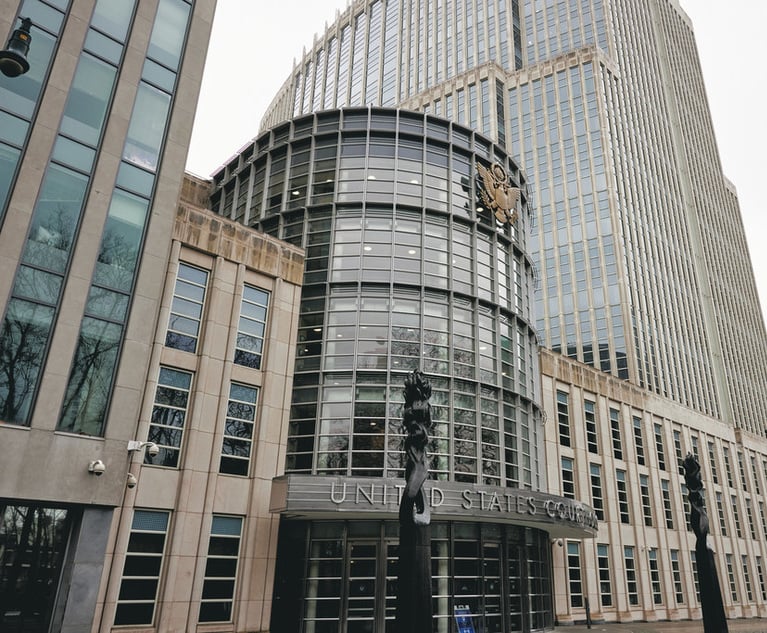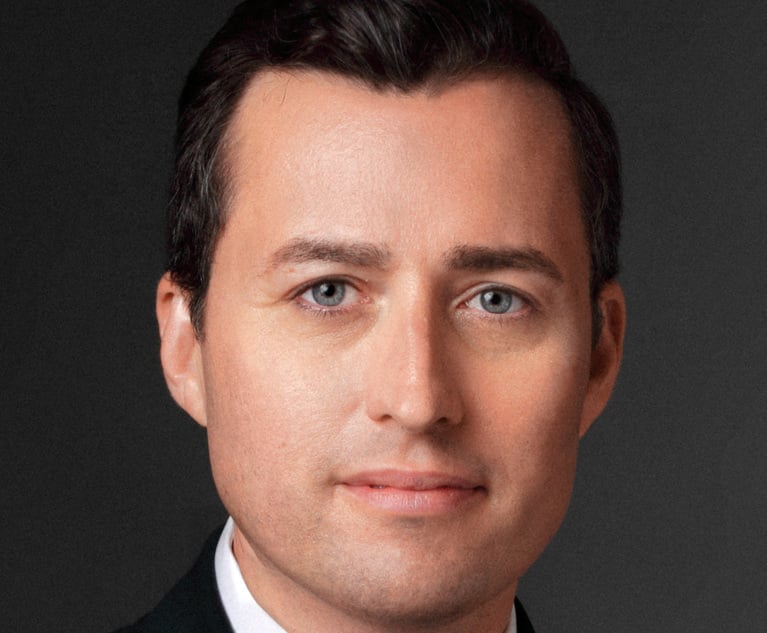The Problems With Insurance for COVID-19 Victims and How To Fix Them
The country needs a workable and economically feasible solution that honors contracts and serves both customers and insurers.
March 30, 2020 at 11:00 AM
10 minute read
 Photo: Kira_Yan/Shutterstock.com
Photo: Kira_Yan/Shutterstock.com
A little-known or remembered fact about the aftermath of the 9/11 terror attacks is that insurance dollars were the first recovery funds to hit the streets in the days following that tragic event. Federal and state funds were weeks in coming and the economy got its first bit of shoring up from business and homeowners (including renters) insurance policies. The insurance industry, in turn, was to be protected from such future events with the passage of the Terrorism Risk Insurance Act (TRIA).
Three years later, in 2004, another crisis caused by a coronavirus—Severe Acute Respiratory Syndrome (SARS)—spread around the globe. Afterward, state legislatures and insurance regulators approved exclusions that precluded insurance coverage for such claims, hastening a movement already underway to exclude infectious diseases from most policies without a specific, and separately purchased, endorsement.
Now that a new crisis—another pandemic—is upon us, federal and state legislators are once again looking for answers to the insurance questions that have arisen in recent weeks. Some are looking to simply ignore the language of policy forms and compel insurers to cover claims via property/casualty coverages, like business interruption/loss of income coverages, while others are proposing making all COVID-19 exposures and subsequent illnesses a workers compensation claim. Still more are looking to the lessons of 9/11 and are proposing a program that tracks the proven precedent of TRIA with a PRIA, the Pandemic Risk Insurance Act.
9/11 showed us that insurance coverages for large-scale events are hugely important to restarting the economy because without insurance a host of economic activity will be curtailed until the wheels of government can get around to not just passing legislation, like the Congress did this past week with the CARE Act, but also translating government policy into meaningful, operational government programs that are actually delivering needed aid.
But forcing insurance coverages on a retrospective basis in situations for which they were not intended and, more importantly, for which premiums were not calculated or collected, could simply spread the contagion that is crippling our economy to yet another sector, as opposed to using this opportunity to develop a new insurance paradigm and have that serve as the basis for insurance coverage going forward.
The right legislation can facilitate insurance playing a positive role in addressing pandemic risks. But post hoc legislation that retroactively overrides the terms of policies approved prior to the pandemic would upend the economics of an industry that is essential to an economic recovery following the current crisis.
Legislation Being Proposed by States
The New Jersey Assembly introduced a bill on March 16 that would—by legislative fiat—override all contract terms, rules, and regulations to mandate that insurers cover business-interruption losses for the current pandemic despite years of well-settled law on the scope of such coverages and specific exclusions in these policies for losses due to viruses. While that legislation was tabled this past week on Tuesday, lawmakers proposed similar bills in Ohio, H.B. 589, Massachusetts, S.D. 2888, and New York A.B. 10226 and other states are likely to follow suit. California, for its part, has directed that insurers provide information on how they are handling claims for business-interruption insurance.
All of these measures would not only effectively rewrite certain business-interruption policies to include the coronavirus pandemic as a covered cause of loss, but would remove the critical components of typical business-interruption policies, namely that there be some form of direct physical damage to an insured's property or that of a nearby property that reflects a peril actually covered by an insured's policy.
Industry concerns were exacerbated when 18 or so members of Congress quizzed insurance carriers and their trade associations about the applicability of business interruption coverages to this crisis. The industry responded in the only responsible way they could—responsible to their existing policyholders and claimants: while they appreciated the challenges in front of all of us, tapping the insurance coverages here would be highly imprudent.
Most business-interruption policies only provide coverage for losses arising from direct physical damage or loss to property, but specifically also exclude COVID-19-like related losses from coverage. Following the SARS outbreak, insurance carriers began to specify exclusions for pandemics in business-interruption policies. The most common such exclusion is titled "Exclusion for Loss Due to Virus or Bacteria." ISO form CP 01 40 07. It states, "We will not pay for loss or damage caused by or resulting from any virus … that induces … physical distress, illness or disease."
A July 6, 2006 circular that the Insurance Services Office (ISO) filed with state insurance regulators specifies viral and bacterial illnesses, including rotavirus, SARS, and influenza, as part of this exclusion. The ISO submission to state regulators made explicit the concerned property policies exclude "contamination by disease-causing viruses." See LI-CF-2006-175.
It is a foundation of the insurance industry that risks be diversified: If a hurricane hits the East Coast, it doesn't hit the West Coast. So insurers collect premiums from all around the country to diversify their risk—to "lay off" the loss by collecting premiums elsewhere. But it is impossible to diversify the risk from a pandemic, that is, by definition, worldwide. The exclusions that regulators approved for pandemics was their tacit acquiescence to this disquieting reality.
The sponsors of the New Jersey bill implicitly acknowledge that the policies that are the subject of the measure do not currently provide business-interruption coverage for claims arising from viral outbreaks. After all, if the policies did offer coverage, a bill mandating how coverage is to be "construed"—or re-construed—would not be necessary.
Of course, the practice of law being what it is, every new incident invites a re-reading and perhaps new interpretation of longstanding policy language. The news of litigation coming out of New Orleans pins the hopes of the plaintiff restauranteur upon an interpretation of direct physical damage language as including the presence of the virus on surfaces. It would be hard to fathom a court, creative lawyering notwithstanding, supporting such an expansion of the definition of direct physical damage to include virtually anything that sits on a surface but does not change its characteristics. Legislators, regulators and others would be re-writing virtually every policy currently in force if they were to try to adopt such an interpretation in legislation or regulatory directive for the virus' very temporary presence on surfaces.
Is Post-Hoc Legislation Even Feasible?
Post-hoc legislation of this sort violates the Contract Clause of the Constitution, which provides that "[n]o State shall … pass any… Law impairing the Obligations of Contracts." A law only conforms with the Contract Clause if it does not substantially impair a contractual relationship, has a significant purpose, and is reasonable and appropriate for its intended purposes. Insurers could also challenge New Jersey's approach as an unconstitutional regulatory taking of property.
Perhaps in an acknowledgment of these challenges, the New Jersey bill suggests that carriers may be reimbursed for the amounts required to be paid to insureds, but it does not explain how the state would cover such costs—other than with taxes levied on the insurance industry. A3844, 219th Leg. (N.J. 2020). There have been state-sponsored reinsurance programs and captive insurance companies created for just such a purpose, but not offering specific details on such financial safety mechanism renders the legislation too speculative to support.
The federal entreaties discussed above pose another legal question: under the terms of the McCarren-Ferguson Act, leaving the regulation of insurance to the States, can the Congress even step in to compel such retrospective regulatory management of existing insurance policies? When the Congress has been frustrated with insurance market conditions, it created new insurance paradigms, such as risk-retention groups, and excluded them from state regulation going forward. It did not, however, reach in to change the way insurance was already being regulated at the state level.
Among the market complications presented in addressing these demands are those posed by the relationship between insurers and reinsurers. If an insurer "voluntarily" pays a policyholder to please a regulator—for a claim not covered in a policy—questions arise as to whether reinsurers may refuse to cover. Likewise, if a direct carrier was compelled to make such coverage available, the reinsurer might find itself in the same uncomfortable position, and perhaps subject to their own regulatory inquiry.
Are There Other Solutions?
There are other, more viable, remedies. Congress is discussing creating a program based on TRIA either by amendment to TRIA or by adoption of the PRIA. But this would, and could, only apply to future catastrophes.
A pandemic is like a terrorist attack, only more: its severity is so great and its impact so widespread that losses are incalculable and thus often uninsurable. PRIA would create a pre-funded risk pool, with the government acting as a bank for premiums. Alternatively, pandemic risk might be backstopped through the securities market in part by the issuance of catastrophic bonds (as with hurricanes).
As for claims arising from COVID-19, there has been discussion about creating a 9/11-type fund paid for by the federal government with some limited administrative involvement from insurers. This approach has the benefit of a proven precedent. Let's add one more possibility: a captive insurer (or re-insurer) that takes monies being provided by the federal government, and puts them in an insurance-themed claims mechanism. The World Trade Center captive was created with the final $1 billion provided by the Congress for the payment of responder claims. Operational shortcomings notwithstanding, this has proven to be an effective method of settling claims where other insurance coverages did not exist.
Pressure on insurers will only increase as the federal and state governments struggle to stanch the economic damage from this insidious foe. For example, states are now demanding policy extensions and no cancellations for non-payment. Insurers are essentially being forced to provide coverage for free. It is one thing for a state to seek such accommodations on behalf of homeowners in a few counties after a flood or a hurricane; it is something else to do this for all coverages in the United States.
If insurers are compelled to cover losses that are either not covered or specifically excluded, there may not be enough capital in the U.S. insurance industry to pay for it. The country needs a workable and economically feasible solution that honors contracts and serves both customers and insurers.
Tancred Schiavoni is chair of the insurance practice group at O'Melveny & Myers. Gregory Serio is a principal at Park Strategies and the former Superintendent of Insurance for the State of New York from 2001 to 2005.
This content has been archived. It is available through our partners, LexisNexis® and Bloomberg Law.
To view this content, please continue to their sites.
Not a Lexis Subscriber?
Subscribe Now
Not a Bloomberg Law Subscriber?
Subscribe Now
NOT FOR REPRINT
© 2025 ALM Global, LLC, All Rights Reserved. Request academic re-use from www.copyright.com. All other uses, submit a request to [email protected]. For more information visit Asset & Logo Licensing.
You Might Like
View All
Insurance Company Sues Over 180 Health Care Providers for Fraud Under RICO
3 minute read
New York Court of Appeals Tightens Pleading Standards Against Insurance Policyholder
7 minute read
Amid Growing Litigation Volume, Don't Expect UnitedHealthcare to Change Its Stripes After CEO's Killing
6 minute read
GE Agrees to $362.5M Deal to End Shareholder Claims Over Power, Insurance Risks
2 minute readLaw Firms Mentioned
Trending Stories
- 1Gunderson Dettmer Opens Atlanta Office With 3 Partners From Morris Manning
- 2Decision of the Day: Court Holds Accident with Post Driver Was 'Bizarre Occurrence,' Dismisses Action Brought Under Labor Law §240
- 3Judge Recommends Disbarment for Attorney Who Plotted to Hack Judge's Email, Phone
- 4Two Wilkinson Stekloff Associates Among Victims of DC Plane Crash
- 5Two More Victims Alleged in New Sean Combs Sex Trafficking Indictment
Who Got The Work
J. Brugh Lower of Gibbons has entered an appearance for industrial equipment supplier Devco Corporation in a pending trademark infringement lawsuit. The suit, accusing the defendant of selling knock-off Graco products, was filed Dec. 18 in New Jersey District Court by Rivkin Radler on behalf of Graco Inc. and Graco Minnesota. The case, assigned to U.S. District Judge Zahid N. Quraishi, is 3:24-cv-11294, Graco Inc. et al v. Devco Corporation.
Who Got The Work
Rebecca Maller-Stein and Kent A. Yalowitz of Arnold & Porter Kaye Scholer have entered their appearances for Hanaco Venture Capital and its executives, Lior Prosor and David Frankel, in a pending securities lawsuit. The action, filed on Dec. 24 in New York Southern District Court by Zell, Aron & Co. on behalf of Goldeneye Advisors, accuses the defendants of negligently and fraudulently managing the plaintiff's $1 million investment. The case, assigned to U.S. District Judge Vernon S. Broderick, is 1:24-cv-09918, Goldeneye Advisors, LLC v. Hanaco Venture Capital, Ltd. et al.
Who Got The Work
Attorneys from A&O Shearman has stepped in as defense counsel for Toronto-Dominion Bank and other defendants in a pending securities class action. The suit, filed Dec. 11 in New York Southern District Court by Bleichmar Fonti & Auld, accuses the defendants of concealing the bank's 'pervasive' deficiencies in regards to its compliance with the Bank Secrecy Act and the quality of its anti-money laundering controls. The case, assigned to U.S. District Judge Arun Subramanian, is 1:24-cv-09445, Gonzalez v. The Toronto-Dominion Bank et al.
Who Got The Work
Crown Castle International, a Pennsylvania company providing shared communications infrastructure, has turned to Luke D. Wolf of Gordon Rees Scully Mansukhani to fend off a pending breach-of-contract lawsuit. The court action, filed Nov. 25 in Michigan Eastern District Court by Hooper Hathaway PC on behalf of The Town Residences LLC, accuses Crown Castle of failing to transfer approximately $30,000 in utility payments from T-Mobile in breach of a roof-top lease and assignment agreement. The case, assigned to U.S. District Judge Susan K. Declercq, is 2:24-cv-13131, The Town Residences LLC v. T-Mobile US, Inc. et al.
Who Got The Work
Wilfred P. Coronato and Daniel M. Schwartz of McCarter & English have stepped in as defense counsel to Electrolux Home Products Inc. in a pending product liability lawsuit. The court action, filed Nov. 26 in New York Eastern District Court by Poulos Lopiccolo PC and Nagel Rice LLP on behalf of David Stern, alleges that the defendant's refrigerators’ drawers and shelving repeatedly break and fall apart within months after purchase. The case, assigned to U.S. District Judge Joan M. Azrack, is 2:24-cv-08204, Stern v. Electrolux Home Products, Inc.
Featured Firms
Law Offices of Gary Martin Hays & Associates, P.C.
(470) 294-1674
Law Offices of Mark E. Salomone
(857) 444-6468
Smith & Hassler
(713) 739-1250






